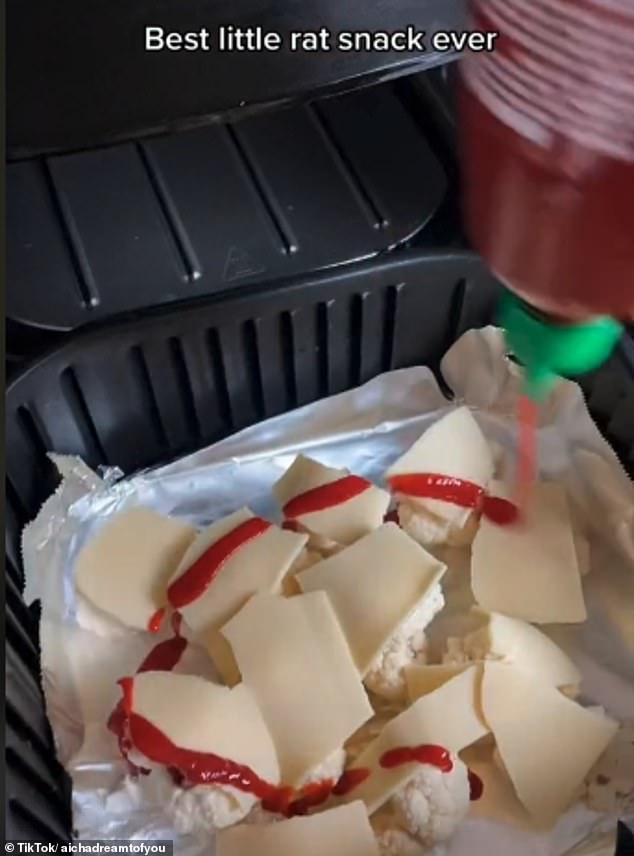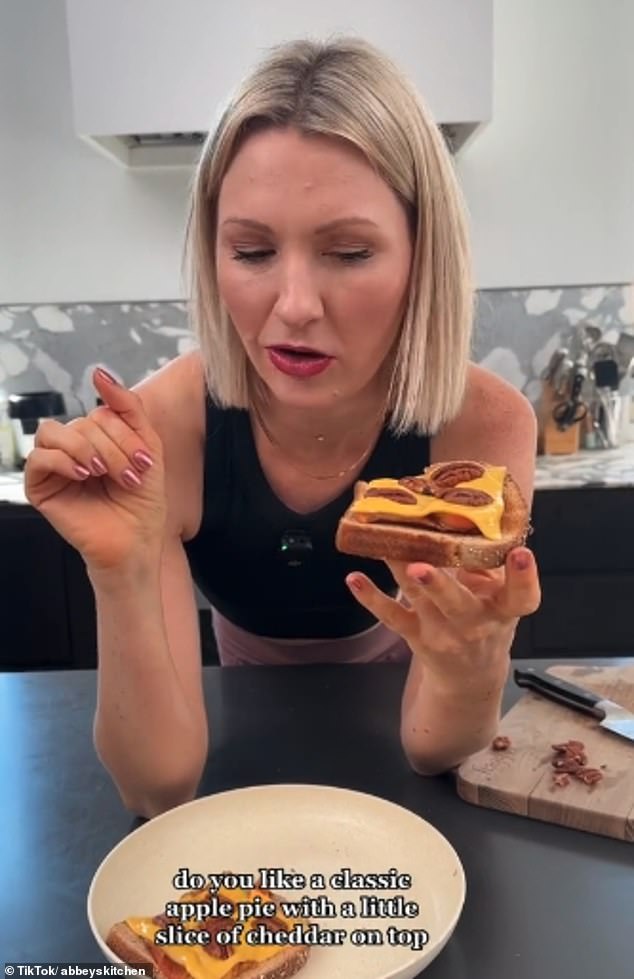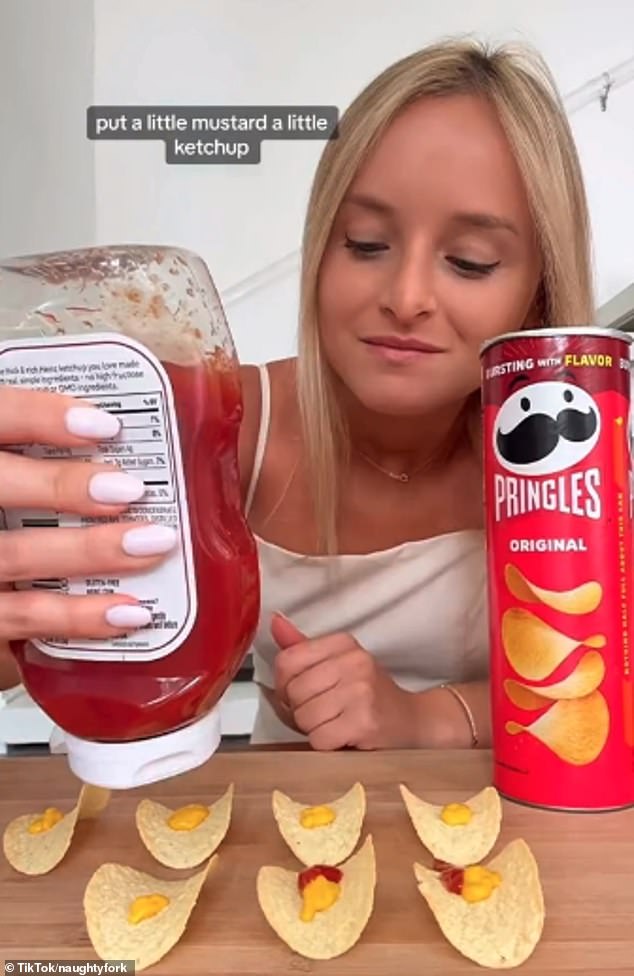Are you a rat snacker? How Gen Z teens are raiding the kitchen cupboards to create weird snack combinations in a new trend – as data from Waitrose shows how snacking is on the rise in Britain
A bizarre TikTok trend is that Gen Z youth are raiding the kitchen cupboards to put together crazy snack combinations – from chili sauce on cauliflower to chocolate on chips.
The strange trend – so-called 'rat snacking' – is for people to mimic the behavior of rodents by scavenging for old leftover food to try to make a meal.
Any unusual food combination would make a “rat snack,” including sprinkling chocolate on a Ritz cracker or mixing hummus with dark chocolate.
Do you make weird snacks? Email katherine.lawton@mailonline.co.uk
The trend is so popular that Waitrose featured it in its annual Food and Drink report, highlighting that young people are likely to swap the traditional three meals a day for snacks.
The report reads: 'Those aged 18 to 24 are the most likely snacking group and social media is flooded with people displaying plates of artfully arranged snacks, marking one of this year's strangest sounding trends in # ratsnacks is started: the unapologetic pleasure of eating unusual snack combinations (that only you enjoy!) often created by raiding the kitchen cupboards.'
In one video, a young woman piles chili sauce on cauliflower, while another shows a girl making a sandwich from just chips and chocolate.

A TikTok video shows a woman making a rat snack from regular chips and chocolate


A TikTok video shows a woman putting cheese and chili sauce on cauliflower to make the 'best little rat snack ever'


The strange trend – called 'rat snacking' – is for people to mimic the behavior of rodents by collecting bits of food to prepare a meal.
Footage posted to TikTok shows the second woman explaining her bizarre snack choice: 'I thought I'd share one of my very strange snacks with you – it's not so strange that it actually makes sense, just to me .
'So I just get ready-made salted chips, just like chocolate. This is just the original flavor.
“Basically I just cut off smaller pieces, and I kind of like to grab a crispy crust and just eat it.” It's so good.'
Food trends and nutritionists have warned that 'rat snacks' usually contain ultra-processed foods, but can also help make a basic snack like chocolate healthier by combining it with other things.
Rhiannon LambertRegistered nutritionist and author, told MailOnline: 'Some of the 'rat snacks' that have gained popularity on TikTok include a pickle wrapped in cheese and crushed chips covered in vinegar in a bowl.
'Many 'rat snacks' contain ultra-processed foods or foods high in salt and fat, but many people combine these UPF foods with healthier foods, so it's a better alternative than just the UPF foods – for example, chips and peanut butter, deli meats and fruit.'
She added: 'Although these are not considered 'healthy' snacks, this trend does encourage a healthy relationship with food to some extent as it does not demonize individual items and in today's time with a crisis in the cost of livelihood you can choose something from!'


A woman adds apples, butter, brown sugar, processed cheese, brown bread and nuts to make her rat snack


Another woman is seen putting mustard and ketchup on pringles and mentioning #ratsnack in the caption
A recent British survey by Waitrose found that 95 percent of respondents said they snacked between meals, while 50 percent said they snacked two or three times a day or more.
Meanwhile, nearly 30 percent say they eat two meals a day, as opposed to the traditional three, and fill up on snacks. One in ten say they eat only one meal a day, while one percent say they skip meals altogether.
Ms Lambert said: 'The traditional three-meal-a-day pattern is evolving rather than dying out completely. Three meals a day still remains a common eating pattern for many, especially families, but we are starting to see a transformation towards 'supplementing' daily intake with snacks.”
She added: 'One reason for the shift from the traditional three meals a day is people's changing lifestyles; busier schedules, longer work hours, more time spent commuting, poverty/food insecurity, living alone and cooking for one person, convenience of snacks and fasting, which can make sticking to set meal times challenging.
'As a result, many people are opting for more flexible eating patterns that accommodate these somewhat chaotic routines.'
Alex Fraysse, dietitian, nutritional therapist and founder of Enchantedsaid: 'There is definitely an increase in the amount of snacks we eat and the main problem with this is that we are constantly activating and restarting our digestive response to the incoming food.


Another woman adds pureed banana and peanut butter to a plain rice cake to make her snack
“We are constantly secreting digestive enzymes, regulating our stomach acid levels, and releasing insulin (especially if the snacks are sugary snacks).”
He added: 'This constant need for snacks can stem from stress and the stress response. When we are stressed, we try to calm ourselves, and what better and easier way to do that than through food during work hours?
'Food becomes our emotional comfort during stressful times, especially the sugary ones, because it helps the body release dopamine (let's call this the feel-good, reward neurotransmitter) and according to brain imaging, it lights up every single part of our brain like a Christmas tree , hence the short-term 'feel good' vibes.
“Starting the day with a sugar-laden meal (think cereal with milk, a fruit bowl, or fruit smoothies) is a surefire way to create snack cravings, as this will spike blood sugar and cause the subsequent crash.”
Waitrose said the increase in working from home could be to blame; 43 percent of people who work from home admit that they are “often in the habit of popping into the kitchen and snacking throughout the day.”
Giles Fisher, Partner and Category Head, Grocery and Frozen, said: 'Some people are looking for small, cheap treats such as crisps and biscuits, while others want healthier snacks such as protein bars.'
Waitrose also revealed that a lack of time could be to blame for the increase in snacking, with 9 percent often eating while walking or on the go.
